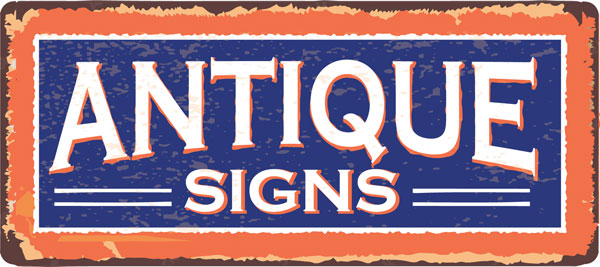The history of enamel signs
Vitreous enamel (or porcelain enamel) signs have a rich and storied history.
Enamel signs as we know them today were likely first produced in the mid-1800s in Germany and Austria when the technique for fusing powdered glass onto iron plates was developed.
The commercial process was patented by Benjamin Baugh in 1859, and he soon began producing enamel signage in his Salt’s Patent Enamel Works in Birmingham, England.
His signs could soon be seen in the surrounding regions and even in the London Trade Exhibition.
Thirty years later, he would go on to open one of the first dedicated enamel sign factories under the name of the Patent Enamel Company, following in the footsteps of a rival company, the Chromographic Enamel Company Limited.
Rising popularity
As word began to spread, demand for enamel signage started to soar. Decorative, durable and weather-resistant, they had a lot to offer.
Competing companies were founded, and a flourishing enamel industry soon appeared in the heart of the Midlands.
During the 1890s, enamel signs had even begun being imported by the United States, which then saw its first domestic producer in the Pennsylvania-based Enameled Iron Company.
The popularity of enamel signage continued to grow as businesses saw the potential appeal of these dazzling new signs.
Over time, reduced production costs and easier access to raw materials led to a surge in usage, with enamel signs soon adorning storefronts across Europe and the United States
Hanging from walls or ceilings, attached to doors and walls, no surface was safe from this novel combination of art and advertising.
The advent of motorised vehicles brought about a popular new flavour of signage, with companies developing flashy and eye-catching signs to quickly capture the attention of drivers and passengers in buses, trams and cars.
War
While World War 1 did little to dampen the enamel sign industry, shortages in World War 2 drastically reduced the amount of signage, particularly in Europe.
War is hungry, and the dire material shortages had countries turning to any source of metal they could find. Unfortunately (or fortunately for some collectors), most porcelain enamel signs were sitting on iron, steel or tin bases, and they were soon melted down for the war effort.
Post-war
By the 1940s and 50s, the heyday of porcelain enamel signs had begun to fade.
The shortages after the war made it prohibitively expensive to produce new signs, and existing signs had been consumed by war, vandals or environmental factors.
The booming post-war economy of the United States wasn’t giving up just yet, though. Often called a golden age of prosperity, the peace and prosperity of 1950s America saw a huge increase in consumerism and manufacturing. And what better way to advertise than with ever more elaborate enamel signs.
This era produced many of the automotive signs that are so popular today, with commanding exorbitant prices among collectors and enthusiasts.
The eventual decline
As technology advanced, advertisers gradually turned their attention to newer and cheaper options.
In the tail end of the 1960s, the convenience and popularity of television as an advertising medium led to it becoming the primary focus for companies and manufacturers.
While signs and billboards remained popular, there were now cheaper options available, such as plastic.
This combination of factors finally drew the curtain on the enamel signage industry as a mainstream medium.
Of course, it remains a niche option to this day, as the timeless and eye-catching charm of a porcelain enamel sign will always draw interest.

